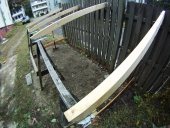I will certainly give it a shot, the only thing is it would be hard to turn the compost so it would just have to sit. I think composted manure is much less acidic and I can always add some of that to the straw.
In further detail the top will be entirely thin glass pieces from aluminum storm doors, one of the side walls will be wood and the back wall is wood as well (fence). The front wall and remaining side wall will be plastic, probably two layers thick with another 2 layers on the inside about 2" apart from the outer layer using the thickness of the 2x4 frame as an air buffer space. I can toy with ideas once it is constructed such as small computer fans to blow warm air into the buffer space between the plastic sheeting...small 12v motors could all be ran off a battery and solar panel.
This is an illustration of the greenhouse, the blue lining is roofing tar paper and the yellow within that is foam insulation board. There will be a false floor to hold the heat down for storage with a few inch gap around all 4 sides to allow warm air to rise against the walls forming a warm shield around the greenhouse like invisible walls of heat. One change I am implementing is the use of some water in my heat sink instead of entirely rock since water holds three times the thermal energy as rock does, I will use the rock to support the false floor though so the rock level will be higher than the water storage containers and with a few drops of bleach I think thick plastic bottles will be fine if surrounded by rock carefully.

One thing you can not see in that illustration is the plumbing system to sink the heat, starting on the right side centered the air rises as it gets hotter and travels along the sloped roof in the strongest sunlight until it reaches the peak against the fence side since heat rises. The very warmest air in the greenhouse gets sucked into that black tube by a DC solar powered fan and pushed under the false floor where it is released through a tube with holes in it that runs down the center of the floor, surrounded by rock and containers of water that store the thermal energy. The trickiest part that I will have to field test is the timing of the fan so that it does not suck cold air off the ceiling at night however since heat rises I would think that is where the warmest air would be night or day anyway and I still need air moving through the floor to release that stored heat, I think people only worry about the system shutting down at night if they are just blowing the top air under their beds and not storing the heat down there.


















